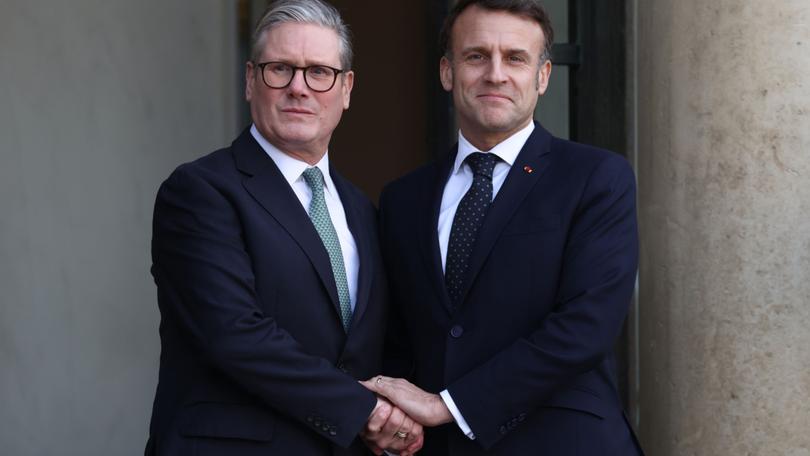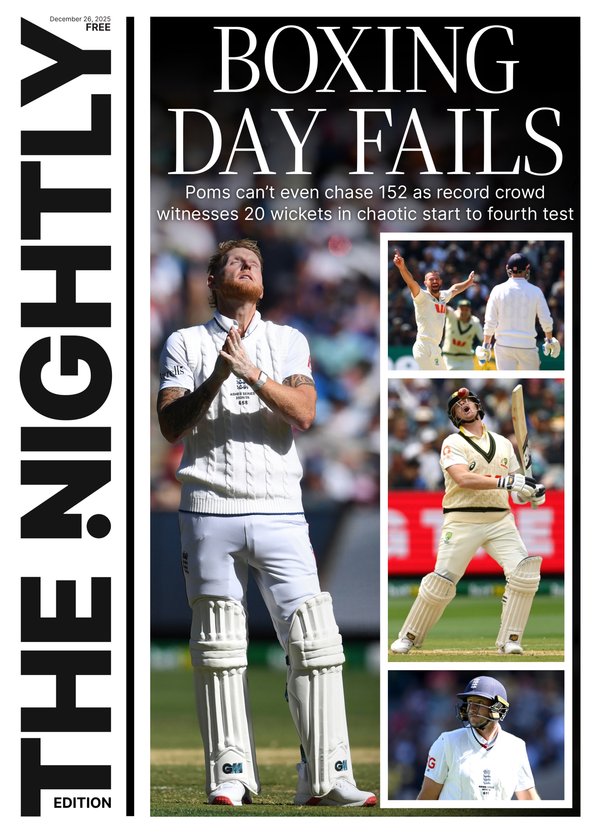THE WASHINGTON POST: Europeans explore troops for Ukraine ceasefire - and want US support

European leaders held an urgently arranged meeting Monday, local time, in part to discuss the potential deployment of their troops to Ukraine under a ceasefire deal, as contacts accelerate between the United States and Russia over halting the war.
The Trump administration has been seeking to learn what forces and weapons European countries could commit, while the Europeans, for their part, have been sounding out the Trump team about what kind of military backing would be available, for instance intelligence or air defences.
The prospect of deploying troops to Ukraine has gained traction among some European leaders in recent days as the Trump administration has moved quickly toward opening direct negotiations with Moscow. Ukraine’s European backers are scrambling for a role in the talks, which are advancing without them but could reshape the continent’s security landscape. US and Russian officials are expected to meet in Saudi Arabia on Tuesday.
Sign up to The Nightly's newsletters.
Get the first look at the digital newspaper, curated daily stories and breaking headlines delivered to your inbox.
By continuing you agree to our Terms and Privacy Policy.French President Emmanuel Macron convened a meeting of some of the continent’s top leaders in Paris on Monday to spur planning on European support for Ukraine and to forge a consensus on a potential deployment. Mr Macron held a 20-minute phone call with President Donald Trump ahead of the meeting.
British Prime Minister Keir Starmer announced for the first time Sunday night that he was ready to deploy British boots in Ukraine as part of a deal “if necessary,” which could pressure other European leaders to make similar pledges.
After Monday’s hours-long huddle, the British leader said that it was early to say how many troops and that there “must be a US backstop.” Yet others, including Germany and Poland, showed hesitation to send their forces.
German Chancellor Olaf Scholz, asked if his country would deploy soldiers, called the discussion “completely premature” as the war rages. “For me, it is quite clear that this is an inappropriate debate at the wrong time and about the wrong topic,” he said.
He welcomed talks to end the conflict but said “this does not mean there can be a dictated peace” and called for a common front between Europe and the United States.
While Washington has ruled out US troops in Ukraine, European officials say the Trump team has not excluded the prospect of supporting a European force and has asked what kind of US backing might be necessary.
The European requests include intelligence, surveillance and reconnaissance capabilities, and potential air cover or some help with air defences to protect the force, four officials briefed on the discussions said.
A US questionnaire sent to European capitals, about forces and equipment they could free up for Ukraine, has also spawned more serious consultations in recent days, said the officials, who, like others, spoke on the condition of anonymity to share sensitive deliberations.
The latest iteration under discussion envisions a “reassurance” or “deterrence” force of a few brigades, possibly 25,000 to 30,000 troops, who would not be stationed along the contact line but would stand ready as a show of force if Russian forces tried to restart the war, they said. The troops could be backstopped by more forces outside Ukraine in case they need to ramp up and move quickly.
France has done more advanced military planning than others and estimates that it could commit nearly 10,000 troops, although other European allies remain more uneasy or have constrained militaries, two of the officials said.
France and Britain, the only two nuclear powers among the Europeans, have been at the forefront of the discussions, which have involved at least a dozen countries, including Poland, the Netherlands, Germany, and Nordic and Baltic states.
Dutch Defence Minister Ruben Brekelmans told The Washington Post the plan would need more than just US political backing. “You also want to have the escalation dominance,” he said, “if tensions would arise and if there would be any conflict. … And we need to have the United States on board.”
“It’s of course about security guarantees for Ukraine, but it’s directly related to our defence and deterrence within NATO,” he said on the sidelines of the Munich Security Conference. “We have discussions among European countries and with the US about what every country can do. Over the next couple of weeks, it needs to become more specific in terms of numbers.”
“It’s a big puzzle, with many pieces that we need to bring together,” he added.
Warnings to Russia
As Mr Trump promised a deal to halt the war, European allies recently grew open to the idea of sending in troops, which had triggered uproar when France’s Mr Macron first suggested it last year.
European leaders have quietly held discussions on troops in Ukraine for months but have yet to draft a concrete plan, with some countries hesitant about committing troops or moving forward without more clarity from the United States about its intentions for Ukraine.
The European plans have gained greater urgency as Trump officials landed on the continent this month and made clear that Washington is more than willing to move without them.
European allies have been split on the nature of a deployment, including the force’s size and mandate and the extent of US backing needed. Attempts to make military plans are also hamstrung by the fact that the parameters of a deal with Russia - such as the lines along which the conflict might be frozen - remain elusive or have not been fully articulated by the Trump team.
Still, officials agree that US support would be critical and that they would welcome clear warnings from Washington to Russia, publicly or privately, against any attempts to attack the force or reignite a full-blown conflict.
Another key question for the Europeans is how to respond if Russia were to attack the force. One proposal was for a mutual-defence clause among countries in the European coalition, which would not operate under the NATO flag.
“It should be clear that the force is ready to hit back if it’s hit, and it should be able to ramp up quickly,” said a European diplomat.
“In a normal world, it would be too early to plan without the ceasefire conditions. But they are going to negotiate over our heads,” the diplomat added. “This is a means to say to the US we are ready to give this if you do that.”
For many European states, a deployment would also require public support at home and draw on already stretched military resources. France has more leeway than others, including Britain, in freeing up troops, partly because of a French drawdown in Africa.
Some countries, such as Poland or Germany, have national elections coming up and are wary of making big moves at a time when Russia’s war in Ukraine has become more politicised. Some have also been nervous about taking risks without greater US involvement. And the Netherlands, for example, will need approval from parliament.
“We do not plan to send Polish soldiers to Ukraine, but we will support, including in terms of logistics and political backing, the countries that may wish to provide such guarantees in the future,” Polish Prime Minister Donald Tusk said Monday.
Chicken and the egg
The European idea also centres on boosting weapons and training for the Ukrainian army so it can hold what is expected to be an unstable ceasefire line. It could become a sticking point in negotiations as Moscow demands that Ukraine significantly reduce its military.
Ukrainian President Volodymyr Zelensky said Monday that he believes “we have made significant progress on the issue” of European troops in Ukraine, which he described as a coalition of the willing. “We want security guarantees not on paper, but on the ground, at sea, in the air,” he said.
Asked whether Russia would be ready for a European deployment in Ukraine, Kremlin spokesman Dmitry Peskov said it was “a very difficult question” on which there have been “no substantive discussions” so far. “It’s difficult to speak about that as it will be NATO member states and, thus, NATO forces deployed on Ukraine’s territory,” he said.
Keith Kellogg, Trump’s special envoy to Ukraine and Russia, visited NATO headquarters on Monday and will tour some capitals this week, when European officials expect to talk about a division of labour with the United States in Ukraine.
A Western diplomat described the talks with the Americans so far as “a chicken-and-egg game,” with each side waiting for the other to show their cards before declaring what resources they could commit.
Others believe the plan would give Europeans a key to shape the negotiations and lock Mr Trump in because he would be loath to appear weak if the force is attacked and his deal unravels. “What would happen if they get attacked and Trump does nothing, it would look so bad for him,” a Western official said.
European officials say they have received mixed messages from members of the Trump team as they try to gauge who does what and how much sway each could have with the president.
“There are different views in the Trump camp … and at the end of the day, he’s the one who decides,” a second European diplomat said. “It could all change with a social media post.”
Serhiy Morgunov in Kyiv, Natalia Abbakumova in Riga, Latvia, and Kate Brady in Berlin contributed to this report.
© 2025 , The Washington Post
